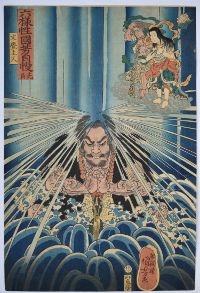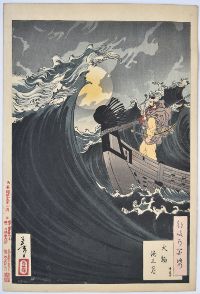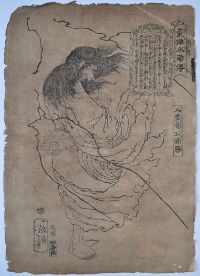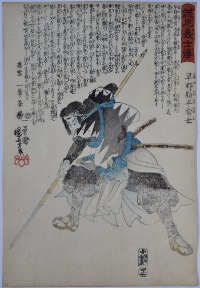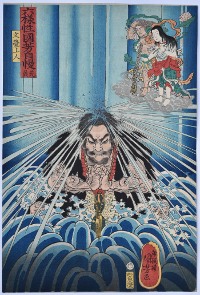/category/warriors-and-legends/page/7/
Utagawa KUNIYOSHI (1797-1861)
Click here to view image full size.
Chinzei Hachiro Tametomo (aka Minamoto no Tametomo) from the set Chuko meiyo kijin den, “Stories of Remarkable Persons of Loyalty and High Reputation.” Published by Iseya Ichiemon or Enshuya Matabei (this design) 1845. Robinson S35.15. He was a renowned archer who was banished to Oshima in Izu and is shown here holding a huge bow made from a tree branch and looking down at a fisherwoman. A large anchor behind.
Superb impression and colour. Very slight crinkling and trimmed close, otherwise fine condition. Signed Ichiyusai Kuniyoshi ga.
Status: Sold
Utagawa KUNIYOSHI (1797-1861)
Click here to view image full size.
The poetess Kikaku from the set Chuko meiyo kijin den, “Stories of Remarkable Persons of Loyalty and High Reputation.” Published by Iseya Ichiemon or Enshuya Matabei (this design) 1845. Robinson S35.6. Shows the Tokugawa poetess sheltering beneath an umbrella in heavy rain in a boat floating under a bridge. A fine design.
Superb impression and colour. Very slight crinkling and trimmed close, otherwise fine condition. Signed Ichiyusai Kuniyoshi ga.
Status: Sold
Utagawa KUNIYOSHI (1797-1861)
Click here to view image full size.
The samurai Yamamoto Kansuke from the set Chuko meiyo kijin den, “Stories of Remarkable Persons of Loyalty and High Reputation.” Published by Iseya Ichiemon (this design) or Enshuya Matabei 1845. Robinson S35.16. One of Takeda Shingen’s most trusted 24 Generals. He is shown fighting a wild boar in deep snow. A fine design.
Very fine impression and colour. Very slight crinkling and trimmed close, otherwise fine condition. Signed Ichiyusai Kuniyoshi ga.
Status: Sold
Utagawa KUNIYOSHI (1797-1861)

Click here to view image full size.
Miyamoto Musashi fencing with Tsukahara Bokuden from the set Chuko meiyo kijin den, “Stories of Remarkable Persons of Loyalty and High Reputation.” Published by Iseya Ichiemon (this design) or Enshuya Matabei 1845. Robinson S35.8. Tsukahara Bokuden was a famous swordsman (1489-1571). He is shown here parrying Musashi’s wooden swords with pot lids. Actually, Bokuden died 13 years before Musashi was born, so this is anecdotal.
Superb impression and colour. Very slight crinkling and trimmed close, otherwise fine condition. Signed Ichiyusai Kuniyoshi ga.
Status: Sold
Utagawa KUNIYOSHI (1797-1861)

Click here to view image full size.
A complete diptych showing Inuyama Dosetsu Tadatomo with smoke curling around him and his hand on one of his swords facing Inugawa Sosuke Yoshito on one knee grasping his sword beside a wood fire from which the billowing smoke is emanating. Two of the heroes from Kyokutei Bakin’s famous book, Nanso Satomi hakkenden, “The Chronicles of the Eight Dog Heroes of the Satomi Clan of Nanso.” From a set of prints Kendo ryaku den “Abridged Stories of Our Country’s Swordsmamship.” Published by Kadzusa-ya Iwazo, c. 1845-6. The complete diptych is rare. Robinson S37.9.7.
Very fine impression, colour and condition. Signed Ichiyusai Kuniyoshi ga.
Status: Sold
Utagawa KUNIYOSHI (1797-1861)
Click here to view image full size.
Chinzei Hachiro Tametomo battling a large wild boar in the snowy mountains of Mashiki in the province of Higo, watched from above by Takama Harutsugu. A rare print from a rare unfinished (?) series Buyu hyaku den, “A Hundred Stories of Military Valour.” Published by Fujioka-ya Hikotaro, c. 1836.
Fine impression and colour. Slight fold, otherwise fine condition. Signed Ichiyusai Kuniyoshi ga.
Status: Sold
Utagawa KUNIYOSHI (1797-1861)
Click here to view image full size.
The priest Mongaku Shonin doing thirty-seven days’penance under the freezing Nachi waterfall near Kyoto. He is helped by Fudo Myo-o’s two attendants Seitaki and Kongara seen here top right. This act of self-mortification is because he accidentally killed his beloved cousin Kesa. Published by Uoya Eikichi, 1860. A fine design.
Very good impression, colour and condition. Signed Cho-o-ro Kuniyoshi ga.
Status: Sold
Tsukioka YOSHITOSHI (1839-1892)
Click here to view image full size.
The best design from the set Tsuki hyakushi, the “Hundred Phases of the Moon.” The set published between 1885 and 1892 (this being 1886) by Akiyama Buemon. Shows Benkei on the prow of the ship in which Yoshitsune was forced to flee to northern Japan after being attacked by his half-brother Minamoto no Yoritomo. Sailing along the Inland Sea off the coast of Harima Province not far from Kyoto, the ship was struck by a storm in Daimotsu Bay caused by the vengeful ghosts of the Taira warriors Yoshitsune and his men had slain. Benkei pacified the spirits by holding up his string of prayer beads.
Fine impression and colour. Light album backing, otherwise very good condition. Signed Yoshitoshi.
Status: Sold
Tsukioka YOSHITOSHI (1839-1892)
Click here to view image full size.
A unique key-block proof of Happinata Kojo (Chin: Xiang Chong) riding into battle on his horse. This appears to be a proof for an unpublished print for the set Goketsu Suikoden, “Heroes of the Suikoden” published by Ohashi in 1868. Keyes lists just seven designs in this set. Aratame and date seal for 7/1868 and engraver’s seal Hori Wakasa. No publisher’s seal. The kento marks just visible. Browned and creased but commensurate with having survived. Sold “as is.” Signed Ikkaisai Yoshitoshi hitsu.
Status: Sold
Tsukioka YOSHITOSHI (1839-1892)
Click here to view image full size.
A key-block proof of Juunryu Kosonsho (Chin: Kun-sun Sheng) praying with lightning flashing around him. From the set Goketsu Suikoden, “Heroes of the Suikoden” published by Ohashi in 1868. Keyes lists just seven designs in this set. Aratame and date seal for 7/1868 and engraver’s seal Hori Wakasa. Publisher’s seal Ohashi (Daikyodo). One kento mark visible. Browned and creased but commensurate with having survived. Sold “as is.” Signed Ikkaisai Yoshitoshi hitsu.
Status: Sold
Tsukioka YOSHITOSHI (1839-1892)
Click here to view image full size.
A unique key-block proof of Kyubiki Toso-o (Chin: Tao Tsung-Wang) brandishing a sword. This appears to be a proof for an unpublished print for the set Goketsu Suikoden, “Heroes of the Suikoden” published by Ohashi in 1868. Keyes lists just seven designs in this set. Aratame and date seal for 7/1868. The outline for the engraver’s seal printed but the name not inserted. No publisher’s seal. The kento marks evident. Browned and creased but commensurate with having survived. Sold “as is.” Signed Ikkaisai Yoshitoshi hitsu.
Status: Sold
Tsukioka YOSHITOSHI (1839-1892)
Click here to view image full size.
A key-block proof of Botsumenmoku Shotei (Chin: Chiao Ting). From the set Goketsu Suikoden, “Heroes of the Suikoden” published by Ohashi in 1868. Keyes lists just seven designs in this set. Aratame and date seal for 8/1868 and engraver’s seal Hori Wakasa. Publisher’s seal Ohashi (Daikyodo). Kento marks visible. Some creasing but commensurate with having survived. Sold “as is.” Signed Ikkaisai Yoshitoshi hitsu.
Status: Sold
Utagawa KUNIYOSHI (1797-1861)

Click here to view image full size.
Nichiren praying for rain from the set Koso goichidai ryakuza, “Illustrated Abridged Biography of the Founder.” The set published by Iseya Rihei, c. 1835. The event is supposed to have taken place at the Reizan Promontory, Kamakura in 1271. Bunei hachi Kamakura Reizangasake uki. Nichiren was the founder of the Buddhist Nichiren sect of which Kuniyoshi was a follower. This is the very rare first edition without the break in the black border on the left near the small boat. Another first edition impression is in the Baur Collection, Geneva. See Matthi Forrer, 1994, G366. Most impressions show the break. For example: Kuniyoshi, Juzo Suzuki, 1992, no. 179. There are also variant later impressions with differences in the gradation of the sea and the promontory.
Very fine impression. Fine colour. Imperceptible centre fold and trimming at top, otherwise very good condition. Signed Ichiyusai Kuniyoshi ga.
Status: Sold
Ichieisai YOSHITSUYA (1822-1866)

Click here to view image full size.
Oeyama Shuten doji. Shows Minamoto no Raiko and his four retainers, from left to right: Sakata no Kintoki, Usui no Sadamitsu, Watanabe no Tsuna and Urabe no Suyetake on Oyeyama, “Devil’s Mountain.” In the year 995 the Emperor commanded Raiko to kill the beast who had been kidnapping and eating young maidens around Kyoto. They accomplished this by dressing as priests and getting Shuten-doji incapacitated with alcohol. Raiko has just decapitated the giant head of the demon which then descends on his helmet which saves him. Published 1855 by Kiya Sojiro . A fine design.
Fine impression and colour. Expert edge repair at top right edge of first sheet, otherwise very good condition. Signed Ichieisai Yoshitsuya ga.
Status: Sold
Tsukioka YOSHITOSHI (1839-1892)

Click here to view image full size.
Nise Murasaki inaka Genji, “An Imposter Murasaki and a Rustic Genji.” A triptych based on an involved story written by Ryutei Tanehiko in 1829 and based on the classic 11th century Tale of Genji. Shows Prince Genji with his lover Tasogare at an old temple. A demon appears pretending to be Genji’s wife Futaba, but in reality is Tasogare’s mother, Shinonome. Genji, discovering her true identity, reveals that his affair with her daughter is only in order to regain the family sword. Tasogare and her mother commit suicide due to the great shame. Published by Akiyama Buemon in 1884.
Fine impression, colour and condition. Signed Yoshitoshi sha.
Status: Sold
Utagawa YOSHITSUYA (1822-1866)

Click here to view image full size.
A triptych showing the defeated generals Shin Chunagon Taira no Tomomori and Sagami Goro Tokiuji of the Taira Clan, having committed suicide, at the bottom of the sea near Yashima Dan-no-Ura in 1185. The Taira were defeated by the Minamoto led by Minamoto no Yoshitsune. Tomomori facilitated his drowning by tying a giant anchor to himself. A large dragon coils around them representing the royal household. Yoshitsuya designed another triptych version of this scene but this interpretation is by far the rarer. Published by Kagaya Kichibei, 1861.
Very good impression, colour and condition. Signed Ichieisai Yoshitsuya ga.
Status: Sold
Utagawa YOSHIKAZU (Active c. 1850-1870)

Click here to view image full size.
A triptych showing The Four Heavenly Kings, loyal retainers of Kiso Yoshinaka (1154-1184) killing a giant snake. Yoshinaka no Shitenno Kiso okuyama ni kore o taiji su. Yoshinaka was a general of the Minamoto Clan. Published by Amatsu, 1851-2.
Fine impression. Very good colour. Sheets attached, otherwise very good condition. Signed Isshunsai Yoshikazu ga.
Status: Sold
Ichiyusai KUNIYOSHI (1797-1861)

Click here to view image full size.
A triptych Buzen no kuni oki manaita ga se, “The Chopping Block Shoals off the Coast of Buzen Province.” Shows the pilot and nobleman Yoshibei leaping to a rock and sacrificing himself to save his ship which was travelling to the capital from Kyushu when it was caught in a violent storm. Published c. 1850 by Mikawaya Tetsugoro. A wonderful and rare triptych.
Fine impression, colour and condition. Signed Ichiyusai Kuniyoshi ga.
Status: Sold
Utagawa KUNIYOSHI (1797-1861)
Click here to view image full size.
The ghost of Hayano Kampei Tsuneyo lunging forward with his spear. From the set Seichu gishi den, “Biographies of Loyal and Righteous Samurai” in other words, The forty-Seven Ronin. Published by Ebiya Rinnosuke, c 1847-8. Robinson S53.47.
Very good impression, colour and condition. This design is beautifully printed, the blue and sumi graded off to indicate the ghostly status of Tsuneyo. Signed Ichiyusai Kuniyoshi ga.
Status: Sold
Ichiryusai HIROSHIGE (1797-1858)
Click here to view image full size.
Oiso no Maihime telling the Soga brothers the whereabouts of Suketsune. From a set Soga monogatari zue, “The Revenge of the Soga Brothers.” A set of 30 prints published by Ibaya Senzaburo, 1848. This famous story has many versions but basically it tells how Kawazu Sukeyasu was murdered by his cousin Kudo Suketsune. Sukeyasu left two sons and his widow remarried a man named Soga. He adopted the two children and they waited patiently for an opportunity to kill Suketsune which came when he was hunting near Mt Fuji. They killed him but were themselves slain in the ensuing battle. This is the first edition, it was republished in 1858 by Yamaguchiya Tobei.
Fine impression and colour. Light album backing, otherwise fine condition. Signed Hiroshige ga.
Status: Sold
Ichiryusai HIROSHIGE (1797-1858)
Click here to view image full size.
Kewaizaka no Shosho cuts her hair to become a nun. From a set Soga monogatari zue, “The Revenge of the Soga Brothers.” A set of 30 prints published by Ibaya Senzaburo, 1848. This famous story has many versions but basically it tells how Kawazu Sukeyasu was murdered by his cousin Kudo Suketsune. Sukeyasu left two sons and his widow remarried a man named Soga. He adopted the two children and they waited patiently for an opportunity to kill Suketsune which came when he was hunting near Mt Fuji. They killed him but were themselves slain in the ensuing battle. This is the first edition, it was republished in 1858 by Yamaguchiya Tobei.
Fine impression and colour. Light album backing, otherwise fine condition. Signed Hiroshige ga.
Status: Sold
Ichiryusai HIROSHIGE (1797-1858)
Click here to view image full size.
Soga no Juro on a horse lower left bids farewell to his lover, Tora Gozen. From a set Soga monogatari zue, “The Revenge of the Soga Brothers.” A set of 30 prints published by Ibaya Senzaburo, 1848. This famous story has many versions but basically it tells how Kawazu Sukeyasu was murdered by his cousin Kudo Suketsune. Sukeyasu left two sons and his widow remarried a man named Soga. He adopted the two children and they waited patiently for an opportunity to kill Suketsune which came when he was hunting near Mt Fuji. They killed him but were themselves slain in the ensuing battle. This is the first edition. It was republished in 1858 by Yamaguchiya Tobei.
Fine impression and colour. Light album backing, otherwise fine condition. Signed Hiroshige ga.
Status: Sold
Ichiryusai HIROSHIGE (1797-1858)
Click here to view image full size.
Soga no Juro and Soga no Goro attack Suketsune in the snow. From a set Soga monogatari zue, “The Revenge of the Soga Brothers.” A set of 30 prints published by Ibaya Senzaburo, 1848. This famous story has many versions but basically it tells how Kawazu Sukeyasu was murdered by his cousin Kudo Suketsune. Sukeyasu left two sons and his widow remarried a man named Soga. He adopted the two children and they waited patiently for an opportunity to kill Suketsune which came when he was hunting near Mt Fuji. They killed him but were themselves slain in the ensuing battle. This is the first edition , it was republished in 1858 by Yamaguchiya Tobei.
Fine impression and colour. Light album backing, otherwise fine condition. Signed Hiroshige ga.
Status: Sold
Ichiryusai HIROSHIGE (1797-1858)
Click here to view image full size.
The Soga brothers bidding farewell to the summer foliage. From a set Soga monogatari zue, “The Revenge of the Soga Brothers.” A set of 30 prints published by Ibaya Senzaburo, 1848. This famous story has many versions but basically it tells how Kawazu Sukeyasu was murdered by his cousin Kudo Suketsune. Sukeyasu left two sons and his widow remarried a man named Soga. He adopted the two children and they waited patiently for an opportunity to kill Suketsune which came when he was hunting near Mt Fuji. They killed him but were themselves slain in the ensuing battle. This is the first edition, it was republished in 1858 by Yamaguchiya Tobei.
Fine impression and colour. Light album backing, otherwise fine condition. Signed Hiroshige ga.
Status: Sold
Utagawa YOSHITSUYA (1822-1866)
Click here to view image full size.
A fine design showing the outlaw Yasusuke Hakamadare surrounded by a giant snake amidst falling leaves. He was able to disguise himself using the skins of animals and this translated into the notion that he could transform himself into these creatures or conjure them up as in the case of the battle between Raiko and Hakamadare where he invocates a giant snake. (The subject of another triptych design by Yoshitsuya.) From a rare set: Dai Nihon jutsu zukushi, “An Assortment of Magic in Great Japan.” This talented pupil of Kuniyoshi had a penchant for snakes, and produced some striking prints. Published 1861.
Fine impression. Very good colour and condition. Full size with extra paper around. Signed Ichieisai Yoshitsuya ga.
Status: Sold
Utagawa YOSHIKAZU (Fl. 1850-1870)
Click here to view image full size.
The battle in snow at the Go-ju-no Pagoda on Mt. Yoshino. Sato Shirobyoe Tadanobu, a follower of Minamoto no Yoshitsune, swiches armour with Yoshitsune to do battle with the warrior monks led by Yokogawa Kakuhan. Published 1858 by Maruya Jinpachi.
Extremely fine impression with extensive splashed and sprayed gofun. Fine impression and condition. Signed Ichijusai Yoshikazu ga.
Status: Sold
Utagawa YOSHIKAZU (Fl. 1850-1870)
Click here to view image full size.
A triptych showing the battle of Shijo Nawate at Yoshino, Nara. Shows Kusunoki Masatsura of the Southern army in the centre amidst a hail of arrows battling the Northern armies in 1348. He was killed in this fight at the age of 22. Published by Sanoya Tomigoro, 1862.
Very good impression and colour. Very slight trimming, otherwise very good condition. Signed Ichikawa Yoshikazu ga.
Status: Sold
Taiso YOSHITOSHI (1839-1892)
Click here to view image full size.
A triptych entitled Autumn Moon. A famous subject showing the aristocrat Fujiwara no Yasumasa playing his flute on a lonely moor and the bandit Hakamadare Yasusuke creeping up on him. So entranced was Hakamadare by the music that all he could do was to follow Yasumasa home. This is a version of a design published in 1868 with partially new blocks and an uncluttered background. It is regarded as a new design. Published by Katada Chojiro, 1884.
Fine impression and colour. Slight edge soil, otherwise very good condition. Signed Yoshitoshi.
Status: Sold
Utagawa KUNIYOSHI (1797-1861)
Click here to view image full size.
Soshiko Raio (Chinese: Lei Heng) gripping the throat of Lady Hakushuyei and about to strike her. A design from the fine set Tsuzoku Suikoden goketsu hyaku-hachi-nin no hitori, “The Hundred and Eight Heroes of the Popular Suikoden, One by One.” Based on the Chinese novel Shui Hu Zhuan, attributed to Shi’Nai’an, which tells of a band of 108 brigands who operated from Liangshan Marsh. Published by Kagaya Kichiyemon, 1827-30. Robinson S2.67.
Fine impression and colour. Full size (unusual as these prints are overlarge obans and usually trimmed down to the common denominator in albums). Signed Ichiyusai Kuniyoshi ga.
Status: Sold
Utagawa KUNIYOSHI (1797-1861)
Click here to view image full size.
The priest Mongaku Shonin doing thirty-seven days penance under the freezing Nachi waterfall near Kyoto. He is helped by Fudo Myo-o’s two attendants Seitaka and Kongara seen here top right. This act of self-mortification is because he accidentally killed his beloved cousin Kesa. Published by Uoya Eikichi, 1860. A fine design.
Superb impression of the first state with splashed gofun over Mongaku’s head. Fine colour. Lightly backed and imperceptible centrefold, otherwise fine condition. Signed Chooro Kuniyoshi ga.
Status: Sold
Taiso YOSHITOSHI (1839-1892)
Click here to view image full size.
Yamauba and Kintoki from a set of thirteen prints Ikkai zuihitsu, “A Miscellany by Ikkai,” this being an early name of Yoshitoshi’s. A strange print in more ways than one: Not only is this his most “Westernized” design, but the impression is a puzzle. There is a thought that the design is based on Raphael’s Santa Familia but it could as easily be a Botticelli. Certainly it looks to be after Madonna and child images he has seen. Also, this set has numerous variations in seals. Basically, it seems those with red or black seals in the margin are the earliest. However, this is a fine impression and has no seals. Published by Masadaya Heikichi, 1872.
Fine impression and colour (with Kintoki a deeper red than on other impressions). Very good condition. Signed Ikkaisai Yoshitoshi hitsu.
Status: Sold
Okumura MASANOBU (1686 -1764)

Click here to view image full size.
An hosoban showing banners for the Boy’s Festival held on the fifth day of the fifth month. These depicted Shoki, the Demon Quellor. One Shoki has come alive and leaps down from the banner to attack an oni – his traditional foe. At the top left on a small banner is the title: Nobori no Shoki, “Shoki the Devil-Quellor.” Masanobu was one of the most influential artists in Ukiyo-e. His long life covered hand-coloured prints through to full colour printing in the mid 1760s and he was one of the first to use the block-printing process after 1740 and pioneer the benizuri-e picture. Extremely innovative: he pioneered the uki-e print, pillar print and ishizuri-e. Not only was he a print artist, he also illustrated books, albums and produced paintings. He started his own publishing house, Okumuraya, which gave him greater control over the printing process. The popularity of his work led to many copies by other publishers, and he had to certify his work as being the “genuine” article. Published c 1725 by Tori-shio-cho, kongen Okumura hammoto. Kono ho no e nise han soro aida hyotan shirushi idashi soro. Provenance: Ex Schindler collection with seal au verso. See Masterpieces Of Ukiyoe-e Prints from The Schindler Collection, Nihon Keizai Shimbun Inc., 1985, no. 8, page 22. Extremely rare.
Very good impression and colour. Urushi: hand coloured with yellow, tan, green and sumi wash. Small edge repair top left, otherwise very good condition. Signed Nihon gwako Masanobu sho-hitsu with Okumura seal.
Status: Sold
Tsukioka YOSHITOSHI (1839-1892)

Click here to view image full size.
Saimyoji Tokiyori Nyudo in the snow from a set of 51 prints Dai Nippon meisho kagami, “A Mirror of Famous Commanders of Great Japan.” The set was published by Ebisuya Shoshichi (the first 11 prints) and Funazu Chujiro between 1878-1882. Tokiyori became Regent (Shikken) in 1246. In 1256 he took the tonsure and was reputed to travel the country incognito to view and better understand the living conditions of the people. Published by Funazu Chujiro in 1878.
Fine, early impression. This is the first state. The snow block was recut on later editions. Fine colour. Light album backing, otherwise fine condition. Signed Oju Yoshitoshi hitsu
Status: Sold
Tsukioka YOSHITOSHI (1839-1892)

Click here to view image full size.
The serpent Tamichi attacking his enemies from a set of 51 prints Dai Nippon meisho kagami, “A Mirror of Famous Commanders of Great Japan.” The set was published by Ebisuya Shoshichi (the first 11 prints) and Funazu Chujiro between 1878-1882. Like Abe no Hirafu, Tamichi was involved in the subjugation of the Emishi. He was killed by a poisoned arrow but was reincarnated as a giant snake to finally overcome his enemies. Published by Funazu Chujiro in 1880.
Fine, early impression with mica on the snake. Fine colour. Light album backing, otherwise fine condition. Signed Oju Yoshitoshi hitsu.
Status: Sold
Utagawa KUNIYOSHI (1797-1861)

Click here to view image full size.
I no Hayata Hironao killing the nue from a set Honcho Suikoden goyu happyakunin no hitori, “One of the Eight Hundred Heroes of the Water Margin of Japan.” In the year 1154 the Emperor Konoe was having trouble sleeping due to weird shrieks and scratchings coming from the roof of his castle. He called for the famed archer Minamoto no Yorimasa (1106-80) to solve the problem. Yorimasa shoots an arrow at a black cloud surrounding the roof and the beast nue falls to earth being finished off by his servant I no Hayata Hironao. The composit creature was said to have the head of a monkey, back of a badger, legs of a tiger, scales of a dragon, and tail of a snake, but accounts vary. Published by Kagaya Kichiemon c 1831. One of the great early designs. Robinson S4a.6. Rare.
Fine impression and colour. In exceptional condition with extra paper on three sides which is extremely unusual. Signed Ichiyusai Kuniyoshi ga.
Status: Sold
Utagawa KUNIYOSHI (1797-1861)

Click here to view image full size.
Wada Heita Tanenaga (1182-1213) battling a giant python (uwabami) near a waterfall.He was a renowned archer and retainer of Minamoto no Yoriie. Various stories tell how he came across the python in a cave or saved a village from its carnivorous attacks. A popular subject that gave rise to some excellent designs by Kuniyoshi and his pupils. From an untitled early set published by Yamaguchiya Tobei, c 1834-5. Robinson S1c.10.
Fine impression and colour.Slightly trimmed at top, otherwise very good condition. Signed Ichiyusai Kuniyoshi ga.
Status: Sold
Tsukioka YOSHITOSHI (1839-1892)

Click here to view image full size.
A vertical diptych showing Taira no Koremochi discovering that a princess is, in reality, a demon. Taira Koremochi Togakushiyama kijo taiji no zu. The story relates how, while maple viewing on Mt. Togakushi in Shinano, Taira no Koremochi comes across a princess and her attendants. He joins them eating and drinking and finally falls into a deep sleep. He dreams that the princess is in fact a kijo (a young woman turned into an oni) and that she is intent on killing him. He awakes to see her true appearance reflected in the water of a nearby stream and kills her. Published by Matsui Eikichi, 1887. It was republished later by Hasegawa.
Very fine impression and colour. Perfect condition with ample room for joining of two sheets and full margin on left and top – which these designs must have. Signed Oju Yoshitoshi.
Status: Sold
Tsukioka YOSHITOSHI (1839-1892)

Click here to view image full size.
A triptych from a set of ten: Dai Nippon shiryaku zue, “Short Illustrated History of Great Japan.” Each print is in the form of an unrolled makimono. This design shows the third son of the twelfth century Emperor Keiko, Yamato Takeru no mikoto (Wo-usu). His father was constantly sending him on dangerous missions making him suspect that he wished his death. One such journey was to the Emishi in northeast Japan. On complaining about this to his high-priestess aunt, Yamato-hime, she gave him the famous sword Ame no murakumo no hoken to aid him. On his arrival, the ruler of the Emishi lured him onto open grassland which he set on fire. Wo-usu used his sword to cut the grass, evade death, and start new fires to kill his enemy. Published by Kobayashi 1880. A fine design.
Fine impression of first edition. Fine colour. Slight album backing, otherwise very good condition. Signed Taiso Yoshitoshi.
Status: Sold
Tsukioka YOSHITOSHI (1839-1892)

Click here to view image full size.
A triptych from a set of ten: Dai Nippon shiryaku zue, “Short Illustrated History of Great Japan.” Each print is in the form of an unrolled makimono. This design shows the twenty-first Emperor Yuryaku-Tenno (457-479) out following his favourite diversion – hunting. The story relates how during 461 on Mount Katsuragi a large boar attacked him. He ordered his aid to shoot it but the man ran away, whereupon the Emperor kicked the boar onto its back and killed it. Published by Tsunashima 1879.
Fine impression of first edition. Fine colour. Slight album backing, otherwise very good condition. Signed Taiso Yoshitoshi.
Status: Sold
Tsukioka YOSHITOSHI (1839-1892)
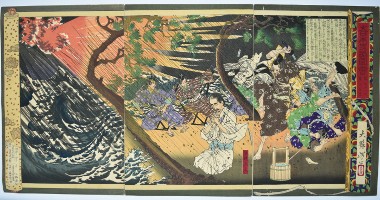
Click here to view image full size.
A triptych from a set of ten: Dai Nippon shiryaku zue, “Short Illustrated History of Great Japan.” Each print is in the form of an unrolled makimono. This design shows the attempted execution of Nichiren during the reign of the ninetieth Emperor Kameyama (1249-1305). Details vary but essentially the attempt was made on the beach at Tatsunokuchi, Kamakura in 9/1271. As the party were passing the shrine of the god Hachiman, Nichiren gave vent to his anger at being unprotected and called on various Buddhist deities. A luminous object shot across the sky and a fierce wind materialized. The soldiers fell to the ground and called off the execution. Published by Morimoto 1879. A fine design.
Fine impression of first edition. Fine colour. Slight album backing, otherwise very good condition. Signed Taiso Yoshitoshi.
Status: Sold




